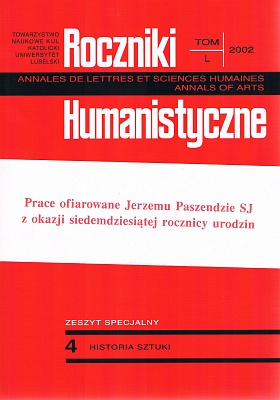Konserwacja trzech obrazów z pojezuickiego kościoła w Łucku
Abstrakt
After 1945 the Polish population left the lands taken over by the Soviet Union. This was the result of the aggression committed against Poland on 17 September 1939, which was sanctioned in the provisions of the conferences in Yalta (February 1945) and Potsdam (July- August 1945). After that the Roman-Catholic cathedral in Łuck (until 1773 a Jesuit church) was closed in 1948 for cult activities by the Bolshevik authorities, similar to most Catholic churches in the Soviet Ukraine. Soon the cathedral was turned into a storehouse, then to a mechanic workshop, and from 1980 the History of Religion and Atheism Museum was opened in it.
The cathedral was regained by the Catholic Church in June 1991. During the past 43 years a lot of unfavourable changes took place in its furnishings. Especially many paintings were lost from the numerous collection enriched in the 19th century by paintings taken from other Łuck churches that belonged to religious orders, closed by the Russian invader authorities.
In 1996 the then cathedral parish priest, Canon Ludwik Kamilewski, applied to the Board of the Polish Association „Wspólnota Polska” („Polish Commonwealth”) in Warsaw to make an inspection and conservation of two paintings rolled on a drum. Conservation works were organized by the Centre for Polish Cultural Heritage Abroad of the Association „Wspólnota Polska” and they were funded by the Senate of the Polish Republic and the Office of the Government Plenipotentiary for Polish Cultural Heritage Abroad. They were done in the years 1997-1999 by the Conservation Team including Krystyna Kokociń ska, Izabela Malczewska (manager) and Halina Rudniewska.
After the works were started it turned out that on the drum there were not two but three paintings from the side altars of the cathedral: Assumption of the Virgin Mary, Apotheosis of St Michael the Archangel (both about 430 x 205 cm) and St Francis of Sales (about 260 x 137 cm).
The state of preservation of the paintings was bad; the losses of paint in Assumption of the Virgin Mary reached about 40% and in the remaining paintings ranged from 10% (Apotheosis of St Michael the Archangel) to 15% (St Francis of Sales). There were also considerable losses of the original canvas, especially on the edges; and the size of the paintings and a lack of a properly equipped room formed hard working conditions for the conservators. After cleaning their back sides all the three paintings were doubled on a new canvas (‘on wax’); next their faces were cleaned with ammonia soap and turpentine; new canvas was inserted in the places where the original canvas was missing and it was ironed; all the losses of the undercoat were complemented with chalk and glue filler and retouched with water-colours and varnished, and when the varnish was dry pointing and reconstruction of bigger paint losses were done in oil and resin; and the paintings were varnished again. For all the three paintings also new frames were made.
On 17 September 1999 the last of the three paintings – Assumption of the Virgin Mary – returned to its original place.
Two of the pictures – Apotheosis of St Michael the Archangel and Assumption of the Virgin Mary – like the painting The Holy Trinity from the high altar (the painting was burnt in 1924) in the first decade of the 20th century were connected with the name of Tadeusz Kuntze, the Polish painter educated in Rome and known there as Taddeo Polacco. Earlier all the three paintings had been attributed to the Polish painter Marceli Bacciarelli. During the conservation on the painting Apotheosis of St Michael the Archangel a hardly legible signature ‘Tadeusz Kuntze 1786’ was found. Finding it allows us to transfer the picture from the group of paintings attributed to that painter to the group of ones that are documented; at the same time it makes probable the information that when during Bishop Karol Niedziałkowski’s rule (1901-1911) in the Łuck diocese the three paintings were taken out of the altars inscriptions were found on them proving that they were painted by T. Kuntze; the above mentioned signature could be one of them.
Tadeusz Kuntze, born in 1733, left Poland for good in 1759 and in 1763 or 1765 he settled down in Rome where he died in 1793. Making the three paintings for the Łuck cathedral was an important order; hence answering the question if the artist executed it in Rome or during a stay in Poland we don not know about would be interesting. May be an answer to this question can be found in the future.
Who painted St Francis of Sales is still unknown. May be this will be changed by research in the archives or by comparative-style studies. During the reported conservation works it was pointed that the painting was initially a little bigger and at a certain moment it was adjusted to the smaller altar niche, which is proven by the painted candlesticks in the upper part of the painting that are cut. This could happen in the 19th century, after possible taking over the painting from one of the Łuck monasteries, closed by the Russian authorities.
The conservation works on the paintings from the Łuck cathedral helped save three precious monuments of the Polish national heritage that are abroad, in the lands that used to be part of the Polish State; now they are common cultural heritage of Poland and the Ukraine.
Copyright (c) 2002 Roczniki Humanistyczne

Utwór dostępny jest na licencji Creative Commons Uznanie autorstwa – Użycie niekomercyjne – Bez utworów zależnych 4.0 Międzynarodowe.





